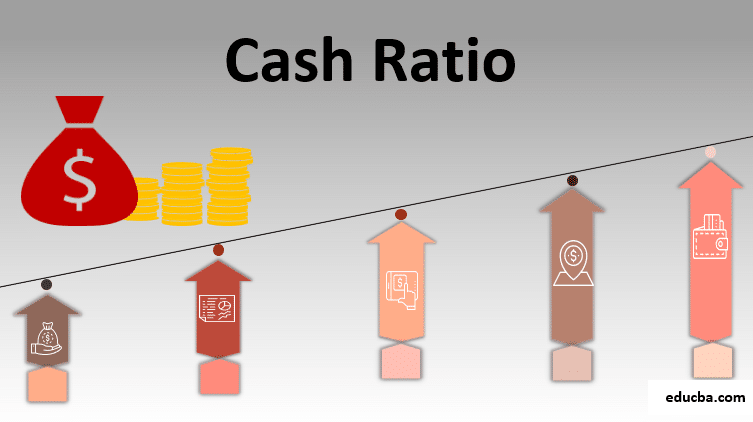The cash ratio is one of three common ways to assess a company’s liquidity. The ratio of a company’s short-term assets to its short-term liabilities is calculated using each form. Learn how to calculate and use the cash ratio with the formula. Also, you’ll learn how it differs from other approaches, like the current ratio and quick ratio.
What is a Cash Ratio?
The cash ratio, also known as the cash asset ratio, is a liquidity metric that measures a company’s ability to pay off short-term debt with cash and cash equivalents. Since only cash and cash equivalents – a company’s most liquid assets – are part of the calculation. It is a stricter, more conservative indicator than other liquidity measures like the current ratio and quick ratio.
The cash ratio is similar to a measure of a company’s worth in a worst-case situation. Worst cases such as when the company is about to go out of business. It informs creditors and analysts of the value of current assets that can be converted into cash easily. Also, it informs them of the percentage of current liabilities that these cash and near-cash assets can cover. Furthermore, it is one of three ways of determining the liquidity of a company.
Key Takeaways
- The cash ratio is a liquidity indicator that demonstrates a company’s ability to meet short-term commitments solely with cash and cash equivalents.
- The cash ratio is calculation is by multiplying a company’s total cash and near-cash securities assets by its total current liabilities.
- Since it only considers a company’s most liquid capital, it is more conservative than other liquidity ratios.
The Cash Ratio: An Overview
Since it only considers cash or cash-equivalent holdings—leaving other assets like accounts receivable out of the equation—it is a more cautious look at a company’s ability to fund its debts and commitments than other liquidity ratios over a short period of time.
Cash Ratio Formula
You can calculate the cash ratio using the following formula:
Cash includes legal tender (coins and currency) as well as demand deposits (checks, checking accounts, bank drafts, etc.). Cash equivalents are assets that one can easily convert into cash. They are easily convertible and carry little risk. Savings accounts, T-bills, and money market instruments are some examples.
Current liabilities are obligations that you must pay within a year. Short-term debt accounts payable, and accrued liabilities are some examples.
How to Calculate Cash Ratio
Company A’s balance sheet goes thus:
- $10,000 in cash
- $20,000 in cash equivalents
- $5,000 in accounts receivable
- $30,000 in inventory
- $50,000 for property and equipment
- $12,000 in accounts payable
- $10,000 in short-term debt
- $20,000 in long-term debt
You can calculate Company A’s cash ratio as follows:
According to the above figure, Company A has enough cash. So, cash equivalents can cover 136 percent of its current liabilities. Company A has a high level of liquidity and can easily fund its debt.
The cash ratio formula, like other liquidity measurements such as the current ratio and the quick ratio, uses current liabilities as the denominator. Any obligation due in one year or less, such as short-term debt, accrued liabilities, and accounts payable, is a current liability.
The key distinction is in the numerator. The numerator limits the asset portion of the equation to only the most liquid assets, such as cash on hand, demand deposits, and cash equivalents, which include money market accounts, savings accounts, and T-Bills.
As with other liquidity measurements, accounts receivable, inventory, prepaid assets, and certain investments are not part of it. The reasoning behind this is that these items may take time and effort to find a buyer in the market. Furthermore, the proceeds from the selling of each of these properties may be indeterminable.
Read Also: How To Calculate Free Cash Flow: Step-By-Step Guide
What Does the Cash Ratio Indicate?
They widely use the cash ratio to assess a company’s liquidity. If a company is required to settle all current obligations immediately, this measure demonstrates the company’s ability to do so without selling or liquidating other properties.
A cash ratio is represented by a number greater or less than one. If the ratio is equal to one, the corporation has the same sum of current liabilities as it does cash and cash equivalents to pay off those debts.
Less than one
After you calculate a company’s cash ratio, and it’s less than one, it indicates that it has more current liabilities than cash and cash equivalents. It indicates that there is insufficient cash on hand to pay off short-term debt. This might not be bad news if the company has factors that distort its balance sheets, such as longer-than-normal credit terms with manufacturers, well-managed inventory, and very little credit extended to consumers.
More than one
When a company’s liquidity ratio exceeds one, it means it has more cash and cash equivalents than current liabilities. In this case, the organization has the potential to pay off all short-term debt while still having cash on hand.
Although this appears to be responsible, a higher cash ratio does not always represent a company’s strong success. This is particularly if it is substantially higher than the industry average. High cash ratios can mean that a business is inefficient in its use of cash or is not maximizing the potential value of low-cost loans. This implies, instead of investing in productive ventures, money is sitting in a bank account. It may also indicate that a business is concerned about potential profitability and is building up a defensive capital buffer.
The Cash Ratio’s Limitations
They rarely use cash ratio in financial statements or by investors in a company’s fundamental research.
It is unrealistic for a corporation to have excessive amounts of cash and near-cash assets on hand to fund current liabilities. Significant quantities of cash on a company’s balance sheet are often regarded as weak asset use, as this capital could be returned to shareholders or used elsewhere to achieve higher returns. Although this ratio provides a fascinating liquidity perspective, its utility is minimal.
When compared to industry and competitor averages, or when looking at changes in the same company over time, the cash ratio becomes more useful. A cash ratio of less than one can sometimes indicate that a company is in financial trouble. A low cash ratio, on the other hand, maybe an indicator of a company’s specific strategy that calls for maintaining low cash reserves—for example, because funds are being used for expansion.
Because certain industries have higher current liabilities and lower cash reserves, cash ratios across industries may not be an indication of trouble.
Differences Between the Cash, Quick, and Current Ratios
Here’s how the cash ratio formula compares to the quick and current ratios:
- Cash ratio = (Cash + Marketable Securities) / Current Liabilities
- Quick ratio = (Cash + Marketable Securities + Receivables) / Current Liabilities
- Current ratio = (Cash + Marketable Securities + Receivables + Inventory)/ Current Liabilities
The Quick Ratio
The quick ratio allows receivables to qualify as short-term assets in addition to assets that are either cash or can be converted into cash in a day or two. The importance of adding receivables as short-term assets varies depending on the specific circumstances of the business involved.
A well-established business may be able to collect receivables from financially stable long-term clients in a short period of time—say, 10 days—on a regular basis. Because receivables have a history of being collected promptly, there is little risk in adding them to the short-term assets side of the equation, even though they are not in the company’s possession. It is reasonable to assume that they will be soon.
Read Also: Equity Multiplier: Calculations, Formula and Examples
The Current Ratio
The current ratio formula, in addition to the quick ratio formula, includes inventory.
The significance of this is determined by the direction of the general economy, the overall health of the company’s business, and the specific business in which the company operates. Inventory is made up of properties that have yet to be sold.
If the inventory reflects a consistent flow of products from suppliers to customers—say, a restaurant’s food inventory—then the additional risk may be minimal.
If the inventory consists of products in a volatile sector, such as fashion, it may be unwise to count as assets goods that may be sold quickly, slowly, at a discount, or never sold at all.
How Effective Is the Cash Ratio?
Many analysts, in general, do not employ this method. It not only assumes a level of risk that is unusual, but it also assigns a value to cash and short-term securities that overestimate their usefulness in a well-run business.
Unless and until you do something with cash, it has little potential for generating a fair return. In certain economic conditions, short-term marketable securities fail to keep pace with the real value loss caused by inflation.
A business with an excessive amount of cash and a heavy reliance on short-term securities is unlikely to be highly profitable.
What is the ideal Cash Ratio for a company?
The ideal Cash Ratio varies depending on the industry and the specific circumstances of the company, but a ratio of 1 or higher is generally considered healthy.
How does the Cash Ratio vary by industry?
The Cash Ratio can vary widely by industry, depending on factors such as the level of competition, the payment terms of suppliers, and the working capital requirements of the business.
How does the Cash Ratio change over time for a company?
The Cash Ratio can change over time for a company, depending on factors such as its revenue growth, capital expenditures, and working capital management.
What is the historical average Cash Ratio for companies?
The historical average Cash Ratio for companies varies widely depending on the industry, but it is typically between 0.5 and 1.
How can a company improve its Cash Ratio?
A company can improve its Cash Ratio by increasing its cash and cash equivalents, reducing its current liabilities, or both.
What are the limitations of the Cash Ratio?
The Cash Ratio is a useful tool for understanding a company’s short-term liquidity, but it has several limitations, including that it does not take into account the quality or risk of a company’s assets, or the terms and conditions of its debts.
Summary
The cash ratio is one of three commonly used tools for assessing a company’s liquidity—its ability to repay short-term debt. It is the most conservative form of the three. You determine this by adding the value of cash and other marketable assets and then dividing it by the total amount of liabilities.
The simple ratio and the current ratio are the other two ways. In general, these metrics are used more often than the cash ratio.
Cash Ratio FAQs
How is cash ratio calculated?
The cash ratio is a liquidity measure that shows a company’s ability to cover its short-term obligations using only cash and cash equivalents. The cash ratio is derived by adding a company’s total reserves of cash and near-cash securities and dividing that sum by its total current liabilities.
Why is the cash ratio useful?
Most commonly, the cash ratio is used as a measure of the liquidity of a firm. This measure indicates the willingness of the company to do so without having to sell or liquidate other assets if the company is required to pay its current liabilities immediately.
Why does Cash ratio decrease?
A decline in this ratio can be attributable to an increase in short-term debt, a decrease in current assets, or a combination of both. Regardless of the reasons, a decline in this ratio means a reduced ability to generate cash.
Does cash ratio include inventory
What’s Included in the Current Ratio? The current ratio measures a company’s ability to pay current, or short-term, liabilities (debt and payables) with its current, or short-term, assets (cash, inventory, and receivables). … Examples of current assets include cash and cash equivalents.
- RETENTION RATIO: How to Calculate it with Examples
- SHORT TERM SOURCES OF FINANCE: BEST OPTIONS FOR ANY BUSINESS (+DETAILED GUIDE)
- Financial Stability: Best Practices & Every detail you should know
- FINANCIAL REPORTING: All you need to know with Examples (+ quick easy tools)
- How Do Nonprofits Make Money? Best 2021 Practices (Updated)
- TRIAL BALANCE: What is Trial Balance & How Does it Work?
- HOUSING RATIO: How to Calculate Housing Ratio with Ease (+ Free Tools)
- Company Profile: 10 Simple Steps to Write Company Profile






